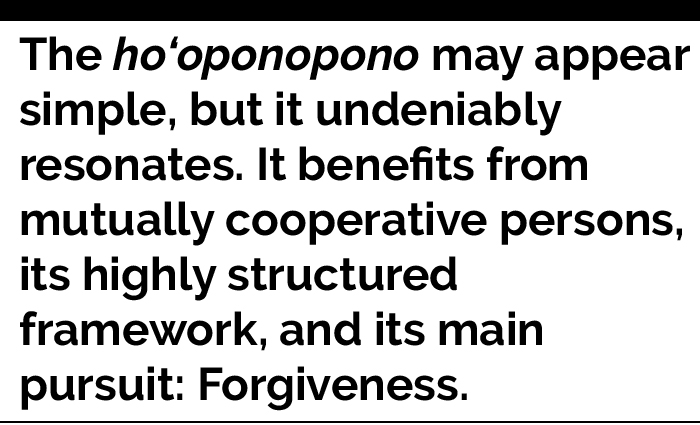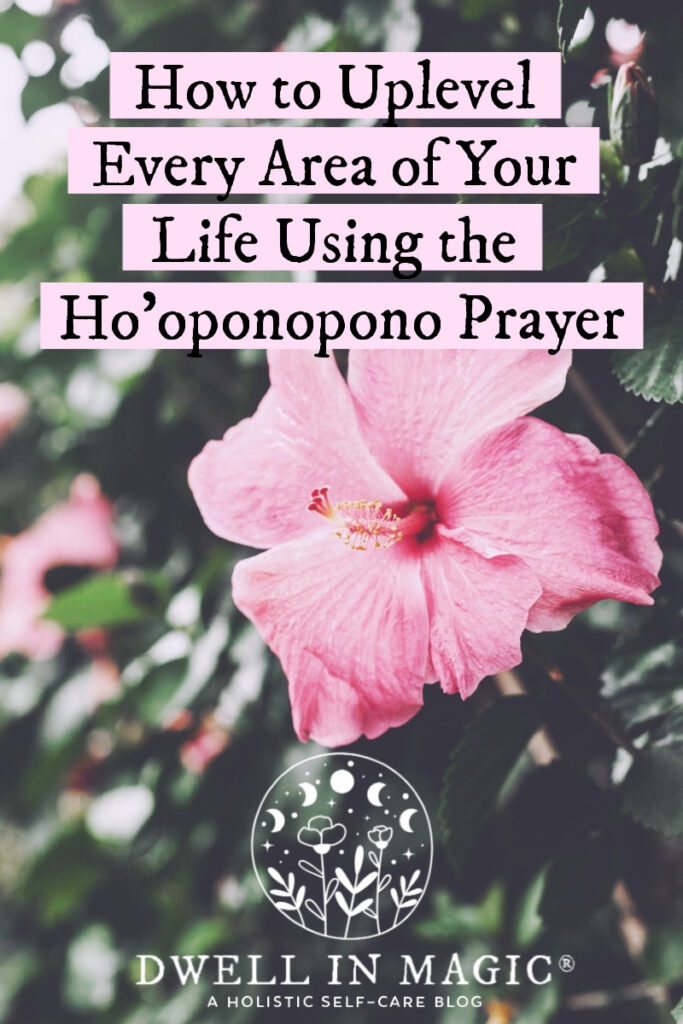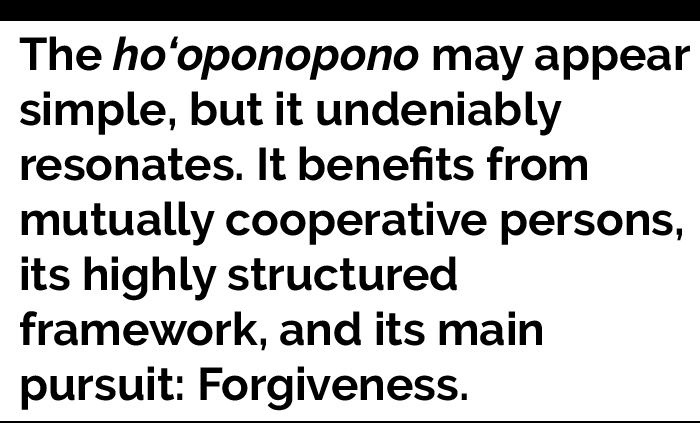Imagine gathering with a group of people, all seeking healing and reconciliation, as you explore the ancient Hawaiian practice of Ho’oponopono. In this captivating article, you will uncover the secrets of how this powerful ritual is conducted in a group setting. Discover the transformative power of shared intentions, collective forgiveness, and the profound impact it can have on both individuals and the community as a whole. Get ready to embark on a journey of healing as we delve into the sacred practice of Ho’oponopono in a group setting.

The Basics of Ho’oponopono
Understanding the concept of Ho’oponopono
Ho’oponopono is a powerful spiritual practice rooted in Hawaiian culture and tradition. It is a way of healing and reconciliation that focuses on taking responsibility for our own thoughts, actions, and emotions. The essence of Ho’oponopono lies in the belief that we are all connected and that healing begins within ourselves. By making amends and seeking forgiveness, we can restore harmony and balance in our lives and relationships.
The origins of Ho’oponopono
Ho’oponopono has its roots in ancient Hawaiian traditions and has been practiced for generations. The word “Ho’oponopono” can be translated as “to make right” or “to correct.” It was traditionally used as a conflict resolution process within families or communities to restore harmony and unity. Over time, the practice of Ho’oponopono has evolved to include individual healing and self-growth, as well as collective healing in group settings.
The key principles of Ho’oponopono
Ho’oponopono is based on several key principles that guide its practice:
-
Taking responsibility: Ho’oponopono emphasizes the importance of taking responsibility for our own thoughts, emotions, and actions. It teaches us that we have the power to make positive changes in our lives by acknowledging our role in any conflicts or challenges we face.
-
Seeking forgiveness: Forgiveness is a fundamental aspect of Ho’oponopono. By seeking forgiveness from others and offering forgiveness to ourselves and others, we can release negative emotions and heal relationships.
-
Letting go: Ho’oponopono encourages us to let go of attachments, resentments, and negative beliefs that hold us back. By releasing these burdens, we can create space for healing and transformation.
-
Gratitude and love: Cultivating a mindset of gratitude and love is essential in Ho’oponopono. By expressing appreciation for ourselves and others, we can foster a positive and healing energy.
Group Ho’oponopono: Benefits and Purpose
Why practice Ho’oponopono in a group?
Practicing Ho’oponopono in a group setting offers unique benefits that complement individual practice. Group Ho’oponopono creates a collective healing space where participants can support and uplift each other on their healing journeys. The power of shared intention and energy amplifies the healing effects, creating a potent environment for transformation.
The power of collective intention
When a group comes together to practice Ho’oponopono, the collective intention becomes a powerful force for healing. The combined focus and energy of the group can create a field of love and healing that extends beyond individual capacities. By aligning with a shared intention, participants can tap into a greater source of healing energy.
Creating a supportive and healing environment
Group Ho’oponopono provides a supportive and nurturing environment where participants can feel safe to express themselves and share their experiences. Being part of a community that understands and empathizes with one another’s struggles can be immensely comforting and healing. The group holds space for each individual, offering support, understanding, and guidance on their healing journey.
Preparing for a Group Ho’oponopono Session
Selecting a suitable location
When organizing a group Ho’oponopono session, it is important to choose a location that is conducive to healing and relaxation. Look for a space that is quiet, peaceful, and free from distractions. Natural environments, such as gardens or parks, can create a harmonious and serene backdrop for the session.
Creating a sacred space
Establishing a sacred space is essential for a group Ho’oponopono session. This can be done by incorporating elements such as candles, incense, flowers, crystals, or sacred symbols. These objects serve as reminders of the sacredness of the practice and help create a focused and harmonious atmosphere.
Gathering essential tools and materials
To ensure a smooth and effective session, gather essential tools and materials beforehand. This might include paper and pens for writing down intentions or reflections, cushions or yoga mats for seating, and any musical instruments or props that may be used during the session. Consider the specific practices or rituals you plan to incorporate and gather the necessary items accordingly.
Setting the Intention and Ground Rules
Defining the purpose of the session
Before beginning the group Ho’oponopono process, it is important to define and communicate the purpose of the session. This can be centered around a specific theme, such as healing a particular relationship or addressing a collective issue. Clarifying the purpose helps create focus and aligns the group’s intentions.
Establishing guidelines for respectful communication
Open and respectful communication is vital in a group Ho’oponopono session. Establish guidelines for how participants should interact with one another, emphasizing active listening, empathy, and non-judgment. Encourage participants to speak from the heart, while respecting each other’s privacy and confidentiality.
Creating a container for open sharing
Create a safe and supportive container for open sharing within the group. Encourage participants to be vulnerable and authentic in their expressions, while ensuring that everyone feels comfortable. Providing a non-judgmental space for sharing allows each individual to feel heard and supported, fostering deeper healing and connection.

Initiating the Group Ho’oponopono Process
Opening ceremony and invocation
Begin the group Ho’oponopono session with an opening ceremony and invocation. This can involve lighting a candle, offering a prayer or intention, or playing calming music to set the tone. The ceremony serves as a sacred space marker and helps participants transition into a focused and receptive state.
Acknowledging and connecting with each participant
Take time to acknowledge each participant and create a sense of connection within the group. This can be done through an opening circle where individuals introduce themselves and briefly share their intention for the session. Acknowledging each person’s presence and unique journey fosters a sense of unity and support.
Explaining the structure of the session
Before diving into the group Ho’oponopono process, explain the structure and flow of the session to ensure clarity and understanding. This may include outlining the practices, rituals, or exercises you plan to incorporate, as well as the intended duration of each segment. Knowing what to expect helps participants feel grounded and engaged throughout the session.
Sharing and Releasing
Creating a safe space for sharing
In a group Ho’oponopono session, it is essential to create a safe space where participants feel comfortable sharing their experiences, emotions, and challenges. Emphasize the importance of active listening, confidentiality, and non-judgmental support. Encourage participants to hold space for one another and to express themselves authentically.
Providing equal opportunity for each participant to speak
Facilitate a supportive environment where each participant has equal opportunity to speak and be heard. Implement a process, such as passing a ceremonial object, to ensure that everyone has a chance to voice their thoughts, feelings, and reflections. This equal distribution of speaking time encourages a sense of inclusivity and helps maintain balance within the group.
Encouraging active listening and support
Encourage participants to actively listen and provide support to one another during the sharing process. This can be done by offering words of affirmation, nodding in understanding, or simply holding space for each other’s experiences. By fostering a supportive and empathetic atmosphere, participants can feel validated and acknowledged in their healing journey.

Ho’oponopono Rituals and Practices
Chanting and toning
Chanting and toning are often used in Ho’oponopono to create a harmonious and healing vibration. Participants can engage in repetitive chants or tones, either collectively or individually, to release stagnant energy and invite positive transformation. The sound vibrations help cleanse and purify the emotions, thoughts, and energetic field of the group.
Using forgiveness prayers and phrases
Forgiveness prayers and phrases form an integral part of Ho’oponopono. Participants can recite forgiveness prayers or affirmations, either silently or out loud, to cultivate a mindset of forgiveness and release. By acknowledging and expressing forgiveness towards ourselves and others, we can dissolve negative emotions and restore harmony within.
Incorporating guided visualizations or meditations
Guided visualizations or meditations provide a powerful tool for group Ho’oponopono sessions. They allow participants to enter a relaxed and receptive state, where they can visualize healing and release. Guided visualizations may involve imagining a healing light or engaging in symbolic actions that represent forgiveness and transformation.
Healing Exercises and Techniques
Energy healing modalities
Group Ho’oponopono sessions can incorporate various energy healing modalities, such as Reiki, sound healing, or acupuncture. These modalities help clear energetic blockages, balance the chakras, and support overall healing and well-being. The collective energy of the group enhances the effectiveness of these practices, promoting deep healing and transformation.
Group breathwork sessions
Breathwork is a powerful tool for releasing stagnant energy and promoting emotional and physical healing. In a group Ho’oponopono session, participants can practice synchronized breathing techniques, such as rhythmic breathing or circular breathing. Together, they create a rhythm and flow that facilitates deep healing and connection.
Emotional release practices
Emotional release practices can be incorporated into group Ho’oponopono sessions to support the release of deeply held emotions and traumas. These practices may include journaling, expressive arts therapy, or group exercises designed to facilitate catharsis. By releasing emotional burdens, participants can experience profound healing and liberation.

Collective Healing and Transformation
Focusing on group healing intentions
Group Ho’oponopono sessions often involve focusing on collective healing intentions. These intentions can be specific to the session’s theme or the needs of the group members. By directing the collective energy towards a shared intention, participants generate a powerful healing field that supports individual and collective transformation.
Utilizing the power of shared energy
The shared energy created in a group Ho’oponopono session is a potent force for healing and transformation. By tapping into this energy, participants can access a deeper level of healing and release. The combined intention and focus of the group amplifies the healing effects, allowing for profound shifts and breakthroughs.
Amplifying the effects of individual healing
Participating in a group Ho’oponopono session amplifies the effects of individual healing work. As each participant engages in their personal healing process, the collective energy of the group amplifies and supports their individual efforts. This synergistic effect enhances the healing potential and accelerates the transformational journey for each participant.
Integrating Ho’oponopono into Daily Life
Carrying the group energy within
After a group Ho’oponopono session, it is important to carry the energy and healing intentions with you into daily life. Maintain a sense of connection with the group and the collective healing energy by reflecting on the session, journaling, or practicing individual Ho’oponopono techniques. By carrying the group energy within, you continue to nurture your healing journey.
Continuing personal forgiveness practice
Ho’oponopono is not limited to group sessions; it can be practiced individually as well. Incorporate forgiveness practices into your daily life by cultivating a mindset of forgiveness towards yourself and others. Use forgiveness prayers or affirmations, engage in personal reflection, and consciously release any negative emotions or attachments that arise.
Staying connected with the group for support
Group Ho’oponopono sessions often foster a profound sense of community and support. Stay connected with the group outside of the sessions through regular check-ins, shared resources, or online forums. By nurturing these connections, you can continue to receive support, encouragement, and guidance on your healing journey.

